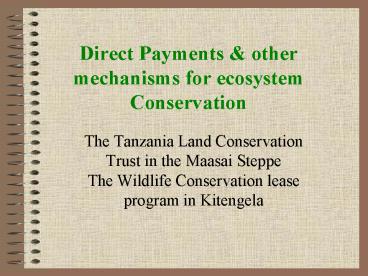Direct Payments - PowerPoint PPT Presentation
1 / 17
Title:
Direct Payments
Description:
AWF's Heartland approach -- focuses on large landscapes of significant wildlife ... Rampant land sales. Value of lease in comparison to land sales. ... – PowerPoint PPT presentation
Number of Views:46
Avg rating:3.0/5.0
Title: Direct Payments
1
Direct Payments other mechanisms for
ecosystemConservation
- The Tanzania Land Conservation Trust in the
Maasai Steppe The Wildlife Conservation lease
program in Kitengela
2
Masai SteppeTarangire-Manyara system
- AWFs Heartland approach -- focuses on large
landscapes of significant wildlife value across
Africa. - Tarangire Manyara one such HL
- Comprises
- Tarangire Nat. Park 2,600 sq. km
- L. Manyara Nat. park 330sq. km
- Dispersal areas --- Simanjiro, and corridors that
link these 2 protected areas - Conservation targets for the landscape
3
The Tanzania Land Conservation Trust
- Registered in July 2000, aims to provide an
alternative mechanism for conserving critical
conservation land in Tanzania. - to benefit conservation and local communities who
live with wildlife adjacent to its lands. - Has a board of 8 Trustees
- Its Trust deed provides for steering committee in
each land that is acquired by the Trust - Has acquired the first piece of land the Manyara
Ranch
4
The Tarangire-Manyara Ecosystem
5
Why Manyara?
- Is an important land unit between L. Manyara and
Tarangire National Parks. - Provides corridor space for elephant, wildebeest
and zebra, is home to populations of eland, oryx,
greater and lesser Kudu, warthog, leopard,
impala, giraffe and is rich in bird life.
6
Acquisition of Manyara
- Government of Tanzania wanted to privatise all
livestock ranches owned by the Narco including
Manyara - Group formed to Lobby against privatisation.
- TLCT proposed as an alternative mechanism
combining community access to particular
resources as well as a revenue share from
ranching and other conservation activities. - Ranch turned over to the Tanzania Land
Conservation Trust (TLCT) through Presidential
order
7
Activities proposed in the Manyara Ranch
- AWF working with the land Trust to
- Develop tourism in the ranch to generate income
- Define areas of access by local communities
e.g. grass banks proposed for dry season use
under conditions to be determined, and water. - Development of a livestock improvement program
for neighbouring pastoral communities
8
Challenges of the TLCT
- New institution
- No funding of its own. Secretariat and project
implementation current supported by AWF - Capacity of the board still weak
- Sustainability issues
- Will it continue to espouse conservation
communities benefits as its key focus - Model untested in TZ
9
The case for Kitengela
- The Kitengela is a part of the Athi-Kapiti
ecosystem which comprises Nairobi National Park,
the Kitengela and individually owned lands. - The ecosystem is approx. 2,500 sq. km.
- The Nairobi park is only 114 sq. km
- Kitengela is located south of the park and
Nairobi City and serves as migratory corridor and
dispersal area for wildlife.
10
Wildlife/Livestock Movement within the Athi-Kapiti
Wet season
Dry Season
Cattle
Wildebeest
Wet season
Dry Season
Zebra
11
Land-Use Changes within Athi-Kapiti
1984
1990
2000
12
Threats to the system
- Growing human population numbers and settlement
- Crop farming
- Fencing and quarrying along the areas previously
used for dispersal and as migration corridors - Changing land use especially rapid since the
early 90s when the EPZ was developed in the
Kitengela
13
Impacts on the wildlife system
- Blockage and or disruption of important migration
routes - Habitat fragmentation and declining access to
critical resources for WL in the ecosystem - Declining numbers of wildlife,
- Increasing conflicts arising from these and other
changes in the ecosystem
14
The Kitengela Lease Program
- Aims to provide a financial incentive to
encourage land owners south of the park to allow
wildlife unrestricted access to their land. - Started in April 2000, initially with 214 acres,
in 2001 grew to 2,708 and in April 2002 was at
7,000 acres. 14,000 acres are wait listed - Landowners are paid US 4 per acre per year a
figure close to the income individuals make from
rearing livestock - Payments made in 3 installments during the year
15
(No Transcript)
16
Challenges to the program
- Rampant land sales
- Value of lease in comparison to land sales.
- Lack of other programs to supplement lease
incomes - Absence of a strong institutional mechanism to
- Hold leases on a long term basis, enforce the
terms of the lease as program grows - Insufficient funds to endow the program
17
- Work on TLCT by AWFs Tanzania Program
- The Kitengela work by Helen Gichohi with support
from Wildlife Conservation Society David
Nkedianye of Friends of Nairobi National Park.

















![Can I Get Direct Deposit To Cash App ? [[ Updated 2021 ]] PowerPoint PPT Presentation](https://s3.amazonaws.com/images.powershow.com/9664268.th0.jpg?_=202109240611)













